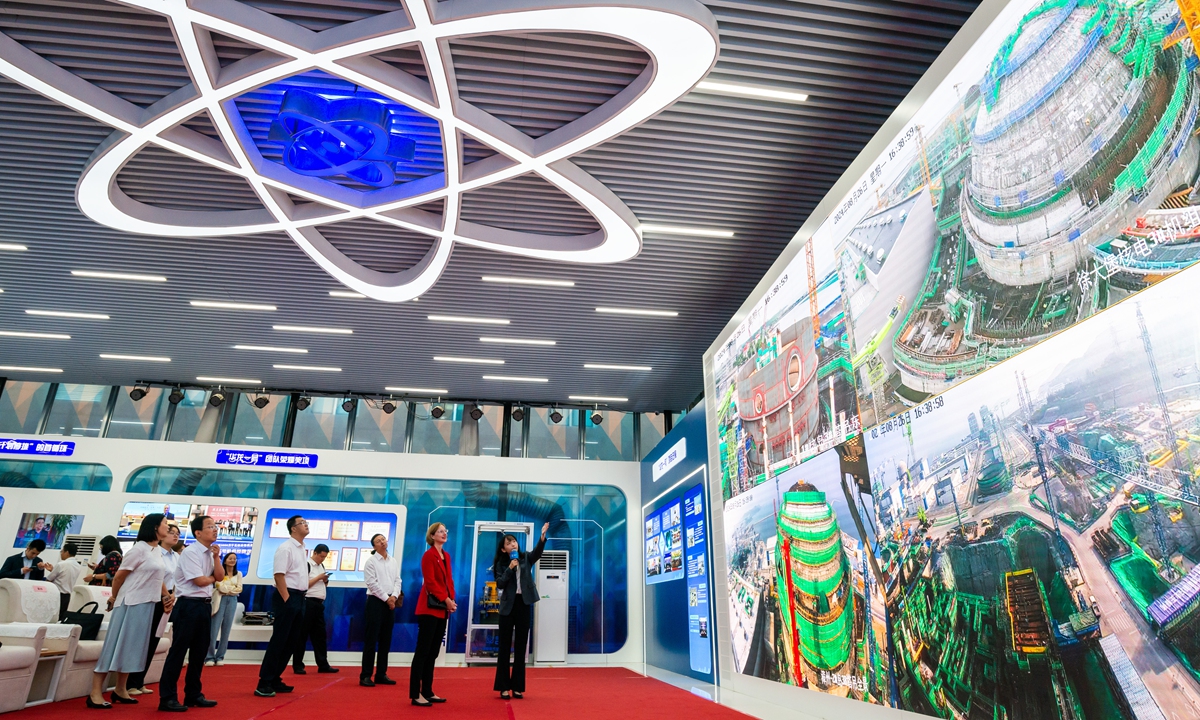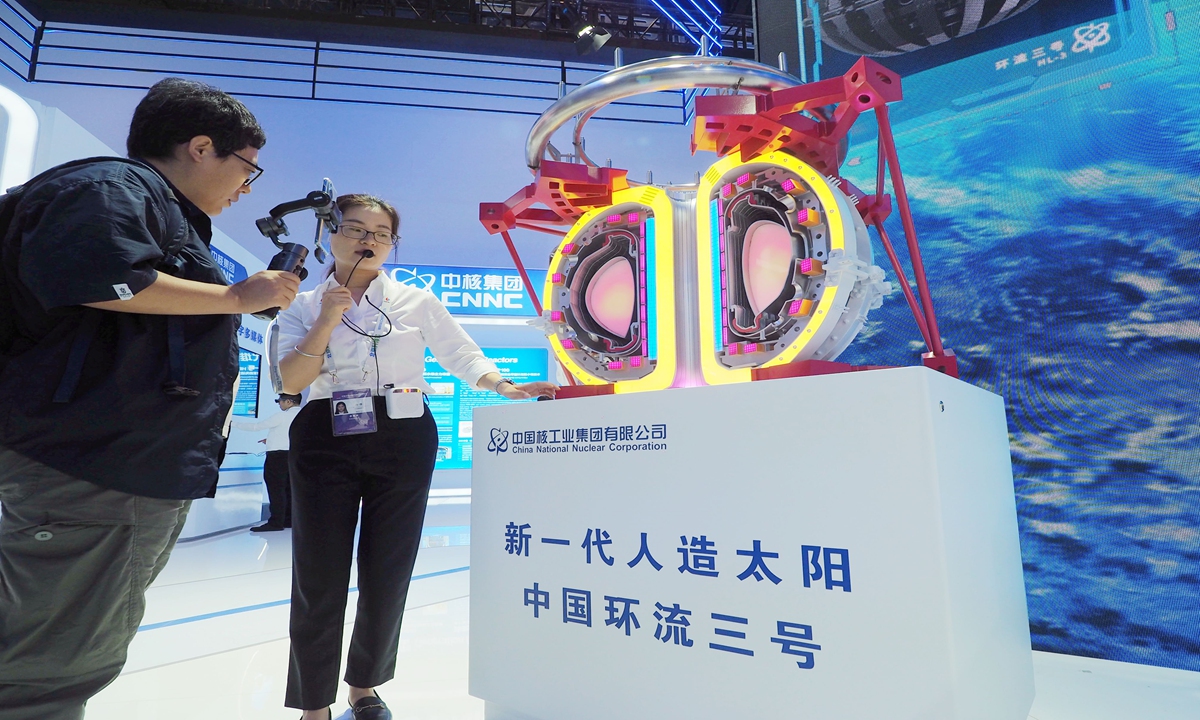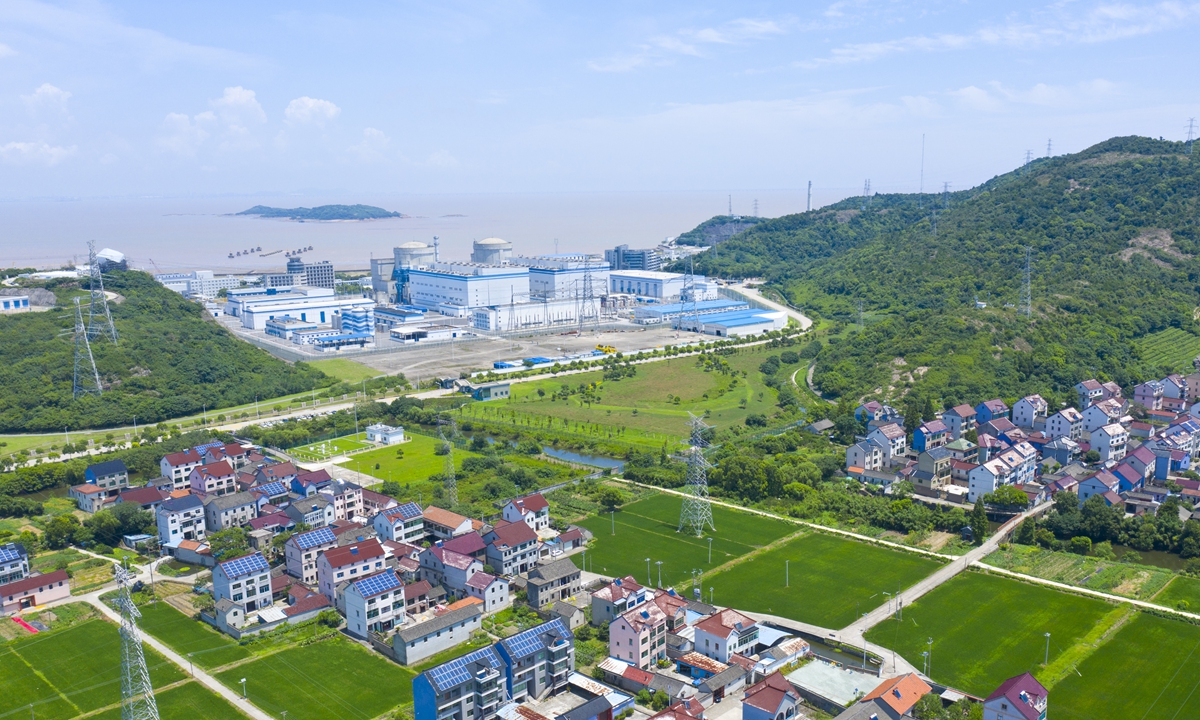
Sophie Boutaud de la Combe, director of IAEA Office of Public Information and Communication, visits CNNC in Beijing on August 26, 2024. Photo: Chen Tao/GT
This year marks the 40th anniversary of China's accession to the International Atomic Energy Agency (IAEA).
Over four decades of development, China's nuclear power industry has become a global leader in scale, technology, and supply chain, serving as a key driver in the international nuclear energy sector.
In the context of a global nuclear energy development landscape where different countries and regions have varying degrees of natural resources, and where the conditions and capabilities for developing nuclear energy differ, the China National Nuclear Corporation (CNNC) actively supports the building of a community with a shared future for mankind. This spirit is underpinned by a philosophy of balanced inclusiveness and open sharing, the CNNC proactively promotes international cooperation to achieve global nuclear energy development goals.
Developing nuclear energy into a clean energy source for large-scale commercial use, and even as a primary energy source, is the sacred mission of CNNC in leveraging nuclear technology to promote harmonious development for all humanity.
Chinese wisdomThrough the years, CNNC has earned public trust through a strong safety record in nuclear facility operations. By fostering an open and inclusive international cooperation environment, CNNC has collaborated with partners to drive innovation in nuclear technology.
Amid the accelerating global green transformation, CNNC always adheres to the development and application of nuclear energy, becoming an important technological force in promoting global sustainable development.
In middle September, in Vienna, CNNC held a conference at the headquarters of the International Atomic Energy Agency (IAEA) to announce the opening of 12 nuclear research facilities to global partners. The move aims to attract foreign institutions and experts to engage in international cooperation activities in China.
The 12 facilities include the China Advanced Research Reactor (CARR), China's new-generation tokamak device Huanliu-3 (HL-3), the Beishan Underground Research Laboratory (Beishan URL) located 560 meters underground, and the Minjiang Test Reactor for irradiation tests and isotope production.
Many of these facilities have also reached world-class level and even lead the industry globally.
According to the CNNC, CARR is an independently developed nuclear reactor, built by China Institute of Atomic Energy (CIAE) under CNNC, with independent intellectual property rights. It provides high-quality, energy spectrum separated thermal and cold neutron beams and it is one of the major neutron sources in the world.
If opening nuclear research facilities to the world symbolizes CNNC's robust commitment to global collaboration and mutual benefit in the realm of "hard science," then actively collaborating with nuclear powerhouses on strategic planning is CNNC's way of envisioning a bright future for global nuclear energy development in the realm of "soft science."
In May, CNNC and the Electricité de France (EDF) jointly launched the "Bluebook" on Nuclear Energy to Support Low Carbon in Paris. The report highlights nuclear energy's pivotal role in addressing climate change and achieving sustainable, low-carbon development. It also emphasizes the importance of nuclear technology in facilitating the global energy transition and ensuring energy security.
The "Bluebook" interprets the development ideas and practices of China and France in the field of nuclear energy through historical reviews and strategic research, providing an in-depth analysis of the future nuclear energy industry from a macro perspective. The research mainly covers the current global environment and trends of nuclear energy development, the role of nuclear power in addressing the climate change, progress in nuclear power safety and related technology standards, in addition to measures to enhance the economic efficiency of nuclear power coupled with other new energy sources, systematically describing the current status of nuclear energy development and scalable practices in China and France.
The "Bluebook" outlines some key initiatives. First, China and France jointly advocate for every nation's right to develop nuclear power, emphasizing that safety must be the top priority, with robust safety oversight in place. Second, it points out to the world that nuclear energy can effectively support low-carbon development. China's future nuclear energy technologies such as small modular reactors and nuclear fusion are important solutions to global energy challenges. Third, it calls for urgent action to address the crisis caused by climate change, emphasizing that energy transformation is imperative, and the development of nuclear power is undoubtedly an effective approach.
Cooperation in the peaceful use of nuclear energy has become a cornerstone of CNNC's international efforts. China joined the International Thermonuclear Experimental Reactor (ITER), the world's largest "artificial sun" project, in 2006. Since the implementation of the project, Chinese enterprises and researchers have played a key role, collaborating with global counterparts and contributing Chinese expertise and resources to ensure the smooth progress of this groundbreaking initiative.
The CNNC has been actively involved in the project. In September 2019, a China-France consortium led by the CNNC signed the Tokamak Assembly Contract 1 (TAC1) with the ITER Organization, marking China's extensive involvement in the installation of the core equipment of the tokamak device - the "heart" of the ITER Machine.
On February 29, 2024, the ITER Organization signed a new contract with the consortium, Vacuum Vessel Sector Modules Sub-Assembly Contract (SMSA).
China will once again lead the installation of the core equipment, contributing wisdom and strength to the ITER project alongside France.
Shen Yanfeng, general manager of the CNNC, said that the signing of the agreement means that the China-France consortium led by the CNNC has become the sole contractor for the tokamak installation of the ITER project at present.
This demonstrates the CNNC's commitment to opening up to the outside world, becoming an active component of the global nuclear industry chain cooperation, building a new development model, promoting high-quality development of the nuclear industry, accelerating the advancement of China's modernization, and striving to create a vivid practice of a global community of shared future for mankind. This will greatly enhance China's participation and contribution in international large-scale scientific projects and help implement China's "three-step" development strategy of nuclear energy - thermal fission reactors, fast reactors, and fusion reactors, Shen said.

A model of next-generation tokamak HL-3 is on display at the China Beijing International High Tech Expo on July 13, 2024. Photo: VCG
International contributionsDeveloping nuclear energy into a clean energy source for large-scale commercial use, and even as a primary energy source, is the sacred mission of CNNC in leveraging nuclear technology to promote harmonious development for all humanity.
Through the years, CNNC has earned public trust through a strong safety record in nuclear facility operations. By fostering an open and inclusive international cooperation environment, CNNC has collaborated with partners to drive innovation in nuclear technology.
Amid the accelerating global green transformation, CNNC always adheres to the development and application of nuclear energy, becoming an important technological force in promoting global sustainable development.
In middle September, local time in Vienna, CNNC will hold a conference at the headquarters of the International Atomic Energy Agency (IAEA) to announce the opening of 12 nuclear research facilities to global partners. The move aims to attract foreign institutions and experts to engage in international cooperation activities in China.
The 12 facilities include the China Advanced Research Reactor (CARR), China's new-generation tokamak device Huanliu-3 (HL-3), the Beishan Underground Research Laboratory (Beishan URL) located 560 meters underground, and the Minjiang Test Reactor for irradiation tests and isotope production.
Many of these facilities have also reached world-class level and even lead the industry globally.
According to the CNNC, CARR is an independently developed nuclear reactor, built by China Institute of Atomic Energy (CIAE) under CNNC, with independent intellectual property rights. It provides high-quality, energy spectrum separated thermal and cold neutron beams and it is one of the major neutron sources in the world.
HL-3, China's largest and most advanced tokamak device, commonly known as the next-generation artificial sun, is designed to support the operation of the International Thermonuclear Experimental Reactor (ITER) and the development of future fusion reactors, according to the CNNC.
The move reflects CNNC's commitment to its international philosophy of equality, mutual benefit, complementary advantages, open cooperation, and win-win outcomes, and is expected to inject fresh momentum into the global advancement of nuclear energy.
"CNNC is willing to take this opportunity to share technological achievements with the world and establish closer cooperative relationships with global research institutions, nuclear energy enterprises, and other experts," said a relevant person in charge of CNNC.
It, in fact, marks the second stage of CNNC's initiative to open its facilities to the world.
CNNC initiated an international cooperation program this year, selecting a number of leading scientific research facilities.
The initiative is aimed to encourage international cooperation and create a high-level international scientific and technological cooperation platform.
In March, the group already announced to open 10 of its advanced facilities and testing platforms to the world.

Picture shows the Qinshan Nuclear Power Base in Haiyan, East China's Zhejiang Province. Photo: Courtesy of CNNC
Potential industryDuring a recent trip to China, Sophie Boutaud de la Combe, director of IAEA Office of Public Information and Communication praised China's significant contributions to the peaceful use of nuclear energy. She highlighted China's efforts in promoting an eco-friendly energy structure and supporting other countries in developing their own nuclear power plants efficiently and at a lower cost.
"China has become a key supporter of the agency through our collaborations, and we have worked together integrating good practices, international standards and peer reviews, especially for safety in the nuclear sector," Sophie said, noting that the IAEA highly values its partnership with CNNC and looks forward to deepening collaboration and exploring the future directions together.
During the visit, industry insiders told the Global Times that while China's nuclear medicine industry still trails behind that of developed countries, it has entered a "fast track" in recent years. This rapid progress in achieving autonomy in key sectors is attributed to supportive policies and pioneering efforts by state-owned enterprises like CNNC.
Moreover, China is actively promoting this emerging industry to developing countries in the Global South. This will not only greatly enhance their public health and quality of life but also empower them to upgrade local industries. The move is becoming an important force in South-South cooperation and in building a community with a shared future for mankind, highlighting China's responsibilities and influence as a major power, the experts said.
According to the China Nuclear Technology Application Industry Development Report (2023), over 150 countries and regions around the world are engaged in the research, development, and application of nuclear technology.
In developed countries, the commercial model for nuclear technology application industry has become relatively mature, with the output value of closely related industries in these countries accounting for more than 2 percent of their GDP, the report noted.
China's figure stood at about 0.6 percent by the end of 2022, as per the data released in the report, but is seeing an annual growth rate of a remarkable 15 percent or more.
"The gap indicates significant growth potential for China's nuclear tech application industry, particularly following the release of a series of key strategic documents," said Yang Wenbin, vice secretary general of China Isotope and Radiation Association.
Medical application is one of the main directions for nuclear technology application, especially radio pharmaceuticals for nuclear medicine. Isotope production is another crucial area for nuclear medicine production. The CNNC, by using two commercial heavy water reactors in the Qinshan nuclear power base, have successfully produced isotope cobalt-60 independently.
In recent years, the CNNC has expanded its cooperation in nuclear medicine with over 50 countries, including nations in Africa, the Asia-Pacific region, South America, Europe, and North America.
"China eyes to extend this technology to more countries, especially developing countries, as it would not only improve the health and well-being of local populations but also bring there a sustainable and thriving industry," said Hou Yanni, deputy director of the IAEA Collaborating Center with the China Isotope & Radiation Corp, a subsidiary of CNNC.






